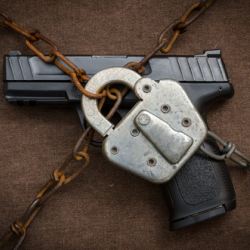Katherine Fowler and her co-authors recently reported in Pediatrics on Childhood Firearm Injuries in the United States this week. They joined data from the National Injury Surveillance System and the National Violent Death Reporting System to find:
- 1297 children (individuals under age 18) died annually in firearm related injury, 53% homicides, 38% suicides and 6% unintentional firearm deaths
- 5790 children were injured in the same time interval.
- Boys were involved more than girls, older children (aged 13 to 17) more than younger children.
- African American children had the highest overall mortality because of homicides. Their rate of 3.5 children/100,000 was twice that of American Indians, four times greater than for Hispanics and ten times greater than for Caucasian or Asian children
- Caucasian and American Indian children had the highest rates of suicide by firearm, four times the rate for African American and Hispanic children and five times greater than for Asian children.
- While the overall rate of unintentional death was lower than for both suicide and homicide, for African American children the rate was twice that of Caucasian and four times the rate for Hispanic children
You will see some obvious flaws in the real data versus how this has been portrayed. While the rates of deaths involved older teens, mainstream media makes it sound like elementary school kids are finding pistols and shooting their friends in alarming numbers. In National Review, Robert VerBruggen brought some sanity to those claims:
I want to focus on suicide and unintentional deaths. And how we need to start looking in the mirror rather than talking about how government is needed to solve this problem.
Suicides were often precipitated by acute crisis or stress and were rightly described as an impulsive act, a ‘crime’ of opportunity. Most children who died from unintentional firearm injury “were shot by another child in their age range and most often in the context of playing with a gun or showing it to others.”
More laws will not fix that, gun laws already prohibit any of these children from owning firearms. These deaths are instead related to access to guns in their homes. That is a parenting issue, not a regulatory one. In states where unsupervised access to firearms by parents is more rigorous, unintentional deaths and suicides (using guns, anyway) for children decrease.
I own firearms, not for defense or hunting, but for shooting trap and sporting clays. I am not a member of the National Rifle Association (NRA). With that disclosure out of the way, here is the point: Responsible parents, responsible gun owners, can reduce the death of our children by locking guns up.
Hiding doesn't work, locks work.
I know the argument that you need to be readily able to get your gun in the instance of a home invasion. There are biometric safes that respond to your fingerprint, though their reliability may be a concern. Safes with digital codes are more reliable but don't use your pin or birthday or something a young person would know.
Who agrees on locking guns up? The NRA.“Store guns so they are not accessible to unauthorized persons.”
The solution to homicides by firearms remains controversial and ‘above my pay grade” as it were, but we can protect our children from firearm death by suicide or unintentional playing around.
By being parents.
We do not need new laws. We need to use common sense and lock up guns. It is time to act responsibly.

